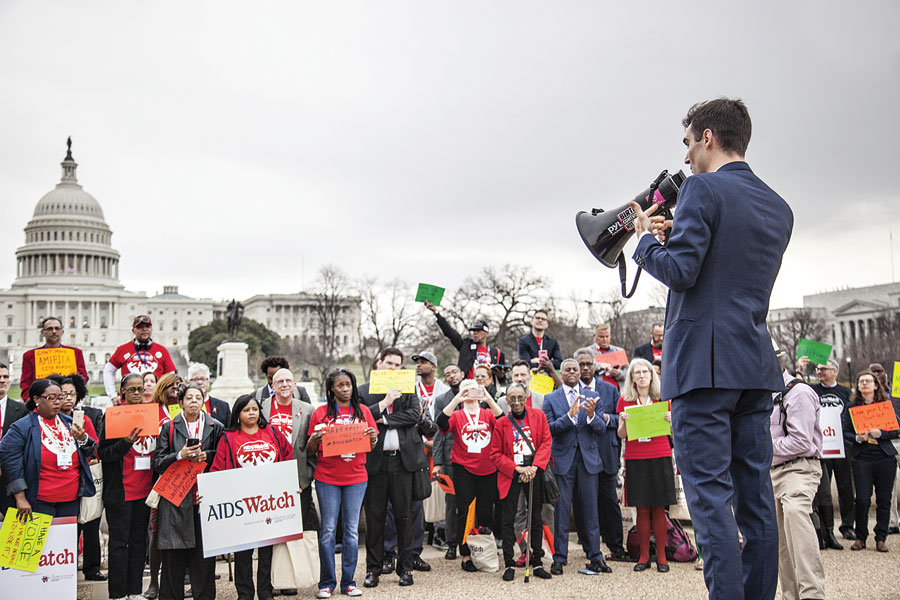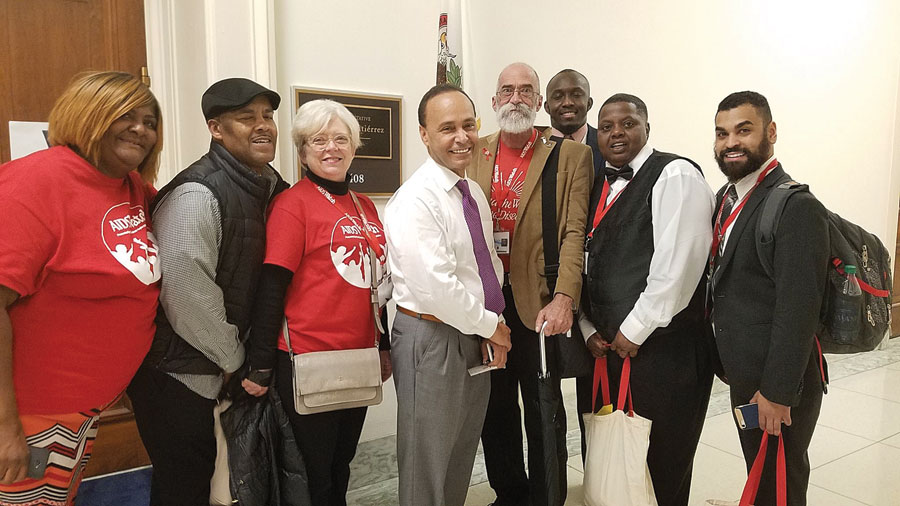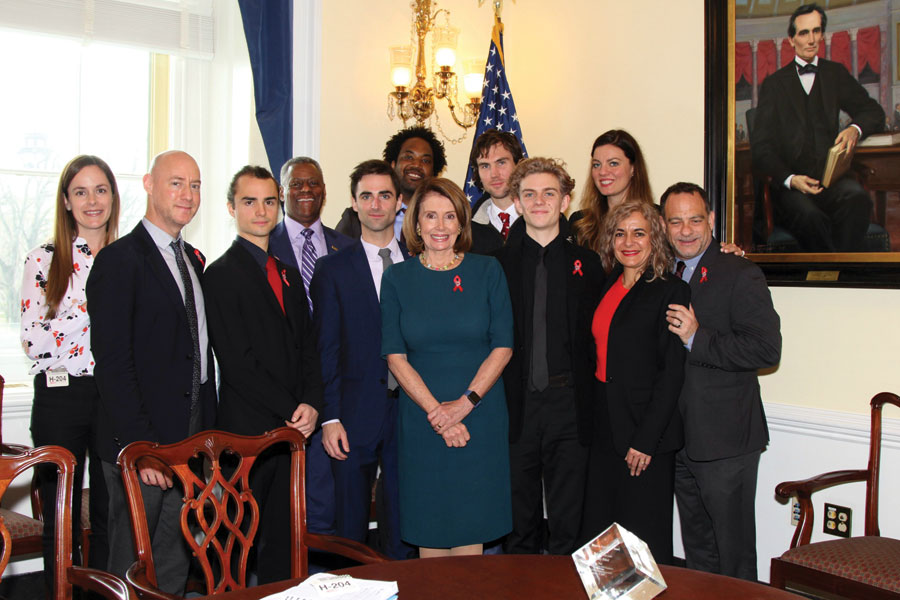

Change in Social Security disability
HIV-positive recipients may now have to go through reviews
People living with HIV (PLWH) who receive government disability checks have previously received that income without going through reviews.
As of March 1, the Social Security Administration (SSA) began requiring that PLWH prove they are still disabled. Like others receiving disability payments, they will have to go through a Continuing Disability Review (CDR). These are conducted every one to seven years.
There are exceptions. Not subjected to a CDR are those with HIV who have
- Multicentric Castleman disease,
- primary central nervous system lymphoma,
- primary effusion lymphoma,
- progressive multifocal leukoencephalopathy, or
- pulmonary Kaposi sarcoma.
“The big take-away here: if you are receiving disability benefits, it is very important to stay in medical care. Document every symptom and have your doctor note them. Document, document, document,” said Marina Kurakin of the Legal Council for Health Justice, in Chicago, who wrote "Money Trail" in the November + December 2016 issue of POSITIVELY AWARE.
She said that one of the biggest concerns now is those who received disability based on mental health status but are not currently seeing a therapist and individuals who are working part-time while receiving disability benefits.
Previously, PLWH were screened out of CDRs. That simply means that they did not have to undergo the reviews. Today, some of those people are actually very healthy. A review may put their disability income at risk.
It’s not yet known when CDRs are expected to begin for people living with HIV. Legal advocates for PLWH, however, point out that the Social Security Administration moves slowly. If there are staff and budget cuts, SSA can be expected to move even more slowly.
Said Bashirat Osunmakinde, Director of Care for the AIDS Foundation of Chicago, in an e-mail to area providers, “The important take-away for HIV-positive folks on disability is this: do your best to keep up with your medical appointments, get all the care you need, and make sure your doctor/nurse/PA/therapist knows everything that’s going on with you. If you do not have ongoing medical records, then when your CDR comes up you won’t have much evidence that you are still disabled. Do not tell your doctor, ‘I’m fine,’ if in fact you are having a lot of trouble with diarrhea and fatigue and neuropathy. Many clients have been so used to their long-standing symptoms that they do not even talk about them with their medical providers anymore, and when they do not communicate their ongoing, longstanding problems to their providers, those problems disappear from the medical record, and thus no longer exist in the eyes of Social Security.”
Osunmakinde also strongly advised Social Security disability recipients to stress to their providers the need to chart everything. “Often, providers will not note in medical records the longstanding, unchanging problems, because they are not actively treating them,” he wrote.
The SSA change came about after the agency revised its criteria for evaluating HIV as a disability on January 17.
See “Yes, SSA Disability Just Made a Slight Change for HIV-Positive Recipients; No, You Shouldn’t Freak Out” at thebody.com. Information about the SSA change, while a little technical, can be found at secure.ssa.gov/apps10/reference.nsf/links/02282017105458AM.
Hep C drug interactions and side effects
In March, U.S. HIV treatment guidelines were updated with drug interactions with hepatitis C medications and side effect information. Go to http://www.aidsinfo.nih.gov/guidelines/html/4/adult-and-adolescent-oi-prevention-and-treatment-guidelines/358/drug-drug-interactions and https://aidsinfo.nih.gov/guidelines/html/4/adult-and-adolescent-oi-prevention-and-treatment-guidelines/359/adverse-dr.
Gilead Sciences awards $22 million for HIV cure research
Pharmaceutical Gilead Sciences early this year announced the recipients of grants for HIV cure research, totaling $22 million. The money will support 12 new cure research projects. Gilead produces the bestselling HIV drugs Truvada and Genvoya, among other antiretrovirals. Read the company’s press release on this commitment at bit.ly/2jsiNSB.
HIV activists seek development of immune drugs
A coalition of HIV activists called for the development of immune enhancement drugs for people with suboptimal immune reconstitution despite years of being on treatment. They called these individuals “immunologic non-responders,” or INRs. The group advocates that scientists, biotech, and pharmaceutical companies pursue therapeutic candidates for INRs. “For example, while gene and anti-inflammatory therapies are being assessed in the context of cure research, there is also evidence that they may have potential to promote immune reconstitution and reduce markers associated with risk of morbidity and mortality in INR patients,” the coalition stated in a press release. Read it at treatmentactiongroup.org/press/hiv-activists-seek-accelerate-development-immune-enhancing-therapies.
Having a baby—Enter the HIVE
HIVE has created a new series of patient materials on safer conception for all persons living with HIV who want to have a baby, including transgender people and gay male couples. Many of the “Thinking About Having a Baby?” materials are available in Spanish. HIVE, formerly known as BAPAC (the Bay Area Perinatal AIDS Center), also has several videos on a YouTube page; go to youtube.com/channel/UC-hwrTcCe_EQ-yjgcFpALVQ. Materials are available for providers as well. Go to hiveonline.org.
WHO publishes hepatitis guidelines
Last November, WHO (World Health Organization) published its first guidelines on testing for chronic hepatitis B and C. According to WHO, “Testing and diagnosis of hepatitis B (HBV) and C (HCV) infection is the gateway for access to both prevention and treatment services, and is a crucial component of an effective response to the hepatitis epidemic.” For more information, go to bit.ly/2ocuP9n. Read the guidelines at bit.ly/2ocixh1.
WHO updates information on HIV and hormonal contraception
In March, WHO updated its guidance on hormonal contraception. “The recommendations for use of progestogen-only injectables among women at high risk of HIV changed from category 1 to category 2, with an accompanying clarification …,” WHO reported. “Women at high risk of acquiring HIV can also use progestogen-only injectables (norethisterone enanthate [NET-EN] and depot medroxyprogresterone acetate [DMPA, intramuscular or subcutaneous]) because the advantages of these methods generally outweigh the possible increased risk of HIV acquisition (MED category 2).” Read the guidance at who.int/reproductivehealth/publications/family_planning/HC-and-HIV-2017/en. See also avac.org/blog/who-updates-guidance-hormonal-contraception-and-hiv. AVAC also conducted a webinar to explain the changes.
Heart study enrolling
Enrollment continues for the REPRIEVE study. REPRIEVE is looking at the use of the cholesterol drug pitavastatin (brand name Livalo) to see if it can prevent heart disease in people living with HIV. According to a study brochure, “Men and women with HIV are 50–100% more likely to develop heart disease.” To qualify for the study, individuals must be between 40 and 75 years of age; on anti-HIV therapy for at least six months; have no history of cardiovascular disease (including heart attack or stroke); and are not currently using a statin medication. The study also provides guidance on nutrition, exercise, and smoking cessation. For more information, call 877-29-HEART (877-294-3278) or go to reprievetrial.org.
June 5 marks 4th annual HIV Long-Term Survivors Awareness Day
“HIV-Resilient” is the theme of this year’s fourth annual HIV Long-Term Survivors Awareness Day (HLTSAD) taking place June 5, according to a press release by Let’s Kick ASS – AIDS Survival Syndrome. This year’s commemoration marks the 36th anniversary of the U.S. Centers for Disease Control and Prevention (CDC) report on June 5, 1981 about five cases of a rare pneumonia affecting young gay men living in New York and California. It was the beginning of what would later come to be known as HIV/AIDS.
HLTSAD co-founder Tez Anderson is looking for people to share stories of survival and resilience on social media using images, words, and videos to illustrate how many years they have been living with the virus.
“Given the current political climate, when our healthcare is being threatened by a new administration, it’s vital that we hear the stories of survivors of the worst epidemic of the modern age,” says Anderson.
People are encouraged to post on social media using the hashtags #HIVResilient, #HLTSAD2017, and #LongTermSurvivors. For additional information, go to HLTSAD.org.
‘F*ck without Fear, PrEP Here’ campaign
Early this year, the Los Angeles LGBT Center kicked off its new PrEP campaign, “F*ck without Fear, PrEP Here.” The asterisk is designed in the shape of five blue tablets, representing the blue Truvada for PrEP HIV prevention pill. “The Center’s sex-positive F*ck w/out Fear campaign uses raw, real language to get people’s attention and spur conversation. It also combats misconceptions about the safety and effectiveness of PrEP and the belief that it’s unaffordable,” the organization reported in a press release. “Those most at risk of HIV are gay and bisexual youth of color and transgender women, but a recent study by APLA Health of young gay and bisexual men revealed that Latino and African-American youth are the least likely to know about PrEP and less than 10 percent are using it. Those who do know about PrEP frequently have misconceptions about it, including the belief that it’s not effective or safe and that it’s unaffordable.”
“Quickly linking newly diagnosed HIV positive people to care can reduce or eliminate the risk they can transmit the virus; it’s the same treatment effect for people who have been living with HIV for a while or a long time,” said Robert Bolan MD, Los Angeles LGBT Center chief medical officer. “Then if HIV uninfected people who are most at-risk of infection successfully protect themselves from the virus, we can effectively end HIV transmission here. Because the availability of condoms alone hasn’t been enough to stop HIV, we’re excited about the promise of PrEP.”
For more information or to book a free online consultation, go to PrEPHere.org.
Consensus statement on lipodystrophy
An international panel of HIV treatment experts published a consensus statement on “the recognition and management of obesity and lipohypertrophy in HIV” in the February 24 issue of Clinical Infectious Diseases. The panel writes that excess fat is related to both the virus and the drugs to treat it. “The metabolic and inflammatory consequences of excess adiposity are critical drivers of non-AIDS events in this population,” they wrote. A discussion of available treatments, including Egrifta and metformin, is included. Read the paper at positivelyaware.com.
New trial for Michael Johnson
A new trial has been ordered for college wrestler Michael Johnson, with the Missouri Court of Appeals determining that important information for the defense had been withheld by the prosecution. In April, the Missouri Supreme Court upheld the decision, and the St. Charles County Prosecutor could retry the case as early as when this issue went to press, according to The Center for HIV Law and Policy, in New York. Johnson had been sentenced to more than 60 years in prison for not informing sex partners that he was HIV-positive, with sentences running concurrently for 30 years. Funds are being raised for his adequate defense. As Plus magazine pointed out in its coverage, “Johnson’s lawyer’s opening words to the jury were apparently, ‘You have to consider my client guilty until proven otherwise.’ The judge reportedly corrected the public defender by saying. ‘I believe you meant to say ‘innocent.’ ” Go to fundedjustice.com/freemichaeljohnson. See also “Michael Johnson, HIV, and Murder: Disclosure and discrimination in criminal law” in the September+October 2015 POSITIVELY AWARE.
Gilead launches new HIV prevention campaign
Gilead Sciences reports that, “In response to community feedback to be more involved in educational efforts to support HIV prevention, and as part of our ongoing commitment to the HIV community, we are pleased to announce Gilead has launched Healthysexual, a new disease awareness campaign focused on generating meaningful conversations among at-risk individuals and their healthcare providers about healthy sexual behaviors, including getting tested, practicing safer sex, and understanding HIV prevention options.” Gilead is the maker of the only HIV prevention pill currently available, Truvada for PrEP. The PrEP pill was FDA approved in 2012. Advocates have long been urging the company to promote the prevention pill. Go to healthysexuals.com.
Harvoni and Sovaldi approved for children
In April, the FDA approved two hepatitis C medications for use in pediatrics: Sovaldi (sofosbuvir) and Harvoni (ledipasvir and sofosbuvir). The medications were approved for children ages 12 to 17 or weighing at least 77 pounds (35 kg). According to the FDA, “These approvals provide pediatric treatment options for six major genotypes, or strains, of the HCV virus.” Harvoni is to be used with genotype 1, 4, 5, or 6 in children without cirrhosis or with compensated cirrhosis. Sovaldi is to be used in combination with ribavirin, in genotype 2 or 3 in children also without cirrhosis or with compensated cirrhosis. For more information, talk with your child’s medical provider. Go to fda.gov.
VIDEO CAPSULE SUMMARIES of news from CROI 2017 by AccessHIV are available at youtube.com/channel/UCQ72ynMDDfXCVK2E0LmUHvA, including the annual HIV Treatment Update by POSITIVELY AWARE Editor Jeff Berry, pictured here with Jonathan Li, MD, and Rick Elion, MD. Read more about CROI in this issue, beginning on page 41.
AIDSWatch 2017
More than 600 activists from across the country arrived in the nation’s capital for AIDSWatch 2017, held March 27 and 28. AIDSWatch brings people living with HIV and their advocates to the Capitol to meet with members of Congress and educate them on the issues affecting the HIV-positive population. According to AIDS United, one of the event’s organizers, "We now have the knowledge and tools to end AIDS in America. We can successfully treat those living with HIV and stop new infections. However, meeting this goal will require substantial scale-up of solutions, removal of barriers, and real leadership." AIDSWatch is presented by the Elizabeth Taylor AIDS Foundation.
Photos courtesy of AIDS United, Sean Black, Harry C. Hopkins, and Roy Ferguson.
Cornelius Baker and Cecilia Chung.
The Elizabeth Taylor AIDS Foundation’s Quinn Tivey (one of Taylor’s grandsons) addresses the crowd.
Meeting with Illinois Congressman Luis Gutierrez (center).
Dr. Carrie Foote on the phone outside the Capitol.
Demonstrating outside the Capitol
Elizabeth Taylor AIDS Foundation and AIDS United meet with with House Minority Leader Nancy Pelosi.









